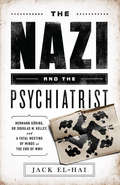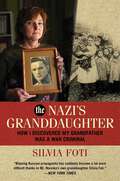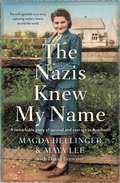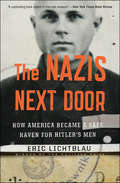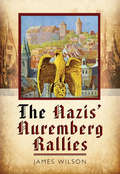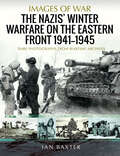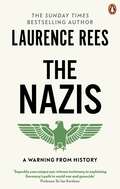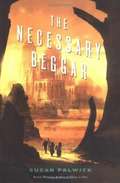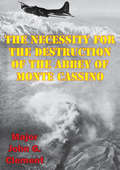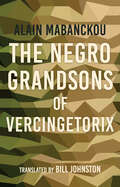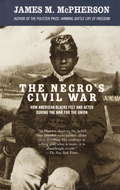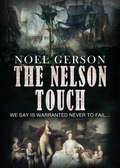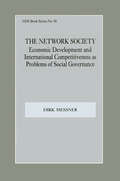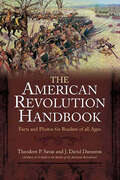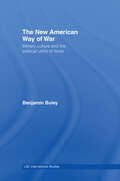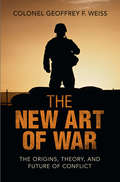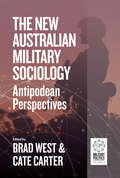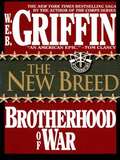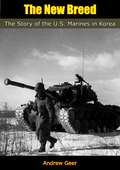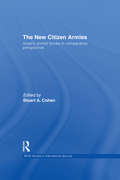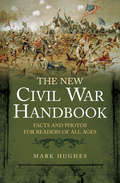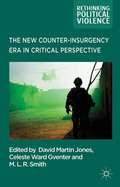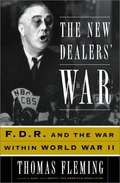- Table View
- List View
The Nazi and the Psychiatrist: Hermann Göring, Dr. Douglas M. Kelley, and a Fatal Meeting of Minds at the End of WWII
by Jack El-HaiIn 1945, after his capture at the end of the Second World War, Hermann Gög arrived at an American-run detention center in war-torn Luxembourg, accompanied by sixteen suitcases and a red hatbox. The suitcases contained all manner of paraphernalia: medals, gems, two cigar cutters, silk underwear, a hot water bottle, and the equivalent of 1 million in cash. Hidden in a coffee can, a set of brass vials housed glass capsules containing a clear liquid and a white precipitate: potassium cyanide. Joining Gög in the detention center were the elite of the captured Nazi regime -- Grand Admiral Döz; armed forces commander Wilhelm Keitel and his deputy Alfred Jodl; the mentally unstable Robert Ley; the suicidal Hans Frank; the pornographic propagandist Julius Streicher -- fifty-two senior Nazis in all, of whom the dominant figure was Gög. To ensure that the villainous captives were fit for trial at Nuremberg, the US army sent an ambitious army psychiatrist, Captain Douglas M. Kelley, to supervise their mental well-being during their detention. Kelley realized he was being offered the professional opportunity of a lifetime: to discover a distinguishing trait among these arch-criminals that would mark them as psychologically different from the rest of humanity. So began a remarkable relationship between Kelley and his captors, told here for the first time with unique access to Kelley's long-hidden papers and medical records. Kelley's was a hazardous quest, dangerous because against all his expectations he began to appreciate and understand some of the Nazi captives, none more so than the former Reichsmarshall, Hermann Gög. Evil had its charms.
The Nazi's Granddaughter: How I Discovered My Grandfather was a War Criminal
by Silvia FotiA deathbed promise leads a daughter on an incredible journey to write about her grandfather who was a famous war hero. But this journey had a terrible destination: the discovery that he was a Nazi war criminal. Silvia Foti&’s mother was dying. Wanting to preserve family history, Silvia&’s mother asks her to write a book about Foti&’s grandfather, Jonas Noreika, a famous WWII hero. Foti&’s grandmother tries to intervene - begging her granddaughter not to write about her husband. &“Just let history lie,&” she whispered. Foti had no idea that in keeping her promise to her mother, her discoveries would bring her to a personal crisis, unearth Holocaust denial, and expose an official cover-up by the Lithuanian government that resulted in an internationally-followed lawsuit. Jonas Noreika was a Lithuanian known as General Storm. He led an uprising that won the country of Lithuania back from the communists, only to have it fall under Nazi control. He was an official during the Holocaust and chief of the second largest region in the country during the Nazi occupation, yet he became a prisoner in a Nazi concentration camp. Foti set out to write a heroic biography about her famous grandfather. But as she dug ever deeper, she &“encountered so much evidence proving my flesh and blood &‘hero&’ was a Jew-killer, even I could no longer believe the lie.&” The Nazi's Granddaughter is Foti&’s first-hand account of her journey, which began as an act of family pride and ended with uncovering the secret her family, and an entire nation, had kept hidden for 79 years. It addresses: How should our family&’s past, shameful or noble, shape our identity? How could one man be revered as a hero, having a grammar school named after him, and yet be a villain responsible for the deaths of thousands? Why are some European countries still in denial about their role in the Holocaust? How was this kept secret until now?
The Nazis Knew My Name: A remarkable story of survival and courage in Auschwitz
by Magda Hellinger Maya LeeThe extraordinarily moving memoir by Australian Slovakian Holocaust survivor Magda Hellinger, who saved an untold number of lives at Auschwitz through everyday acts of courage, kindness and ingenuity. In March 1942, twenty-five-year-old kindergarten teacher Magda Hellinger and nearly a thousand other young Slovakian women were deported to Poland on the second transportation of Jewish people sent to the Auschwitz concentration camp. The women were told they'd be working at a shoe factory. At Auschwitz the SS soon discovered that by putting Jewish prisoners in charge of the day-to-day running of the accommodation blocks, camp administration and workforces, they could both reduce the number of guards required and deflect the distrust of the prisoner population away from themselves. Magda was one such prisoner selected for leadership and over three years served in many prisoner leader roles, from room leader, to block leader – at one time in charge of the notorious Experimental Block 10 where reproductive experiments were performed on hundreds of women – and eventually camp leader, responsible for 30,000 women. She found herself constantly walking a dangerously fine line: using every possible opportunity to save lives while avoiding suspicion by the SS, and risking torture or execution. Through her bold intelligence, sheer audacity, inner strength and shrewd survival instincts, she was able to rise above the horror and cruelty of the camps and build pivotal relationships with the women under her watch, and even some of Auschwitz's most notorious Nazi senior officers including the Commandant, Josef Kramer. Based on Magda's personal account and completed by her daughter Maya's extensive research, including testimonies from fellow Auschwitz survivors, this awe-inspiring tale offers us incredible insight into human nature, the power of resilience, and the goodness that can shine through even in the most horrific of conditions.
The Nazis Next Door: How America Became a Safe Haven for Hitler's Men
by Eric LichtblauRead the history behind the series THE HUNTERS (starring Al Pacino) in this &“captivating book rooted in first-rate research&” (New York Times Book Review) that tells the true story of how America became home to thousands of Nazi war criminals. For the first time, once-secret government records and interviews tell the full story of the thousands of Nazis—from concentration camp guards to high-level officers in the Third Reich—who came to the United States after World War II and quietly settled into new lives. Many gained entry on their own as self-styled war &“refugees.&” But some had help from the U.S. government. The CIA, the FBI, and the military all put Hitler&’s minions to work as spies, intelligence assets, and leading scientists and engineers, whitewashing their histories. Only years after their arrival did private sleuths and government prosecutors begin trying to identify the hidden Nazis. Now, relying on a trove of newly disclosed documents and scores of interviews, Eric Lichtblau reveals this shocking, shameful, and little-known chapter of postwar history. New York Times bestseller — Espionage category &“Disturbing.&” — Salon &“Engaging.&” — Chicago Tribune &“A gripping chronicle.&” — Times of Israel &“Riveting . . . An important, fascinating read.&” — Jewish Book Council
The Nazis' Nuremberg Rallies
by James Wilson&“An amazing collection of original photographs and postcards relating to the Nuremberg rallies of the Nazis . . . the book is dazzling.&” —War History Online This book describes the background to and the development of the Nazi Party Rallies held at Nuremberg each September from 1933 to 1939. These Reichsparteitage (National Party Days) were vast and meticulously staged managed extravaganzas in which ritual and ceremony played an important part. The Rallies had two key objectives. The first was to focus public attention on the successes of the Nazi Party and connect with the public conscience and build a close bond between Party and people. Even more important was the Rallies&’ role in presenting Adolf Hitler as the savior of the German nation sent to restore national pride, power and prosperity after the shame and economic disaster of the post war years and the deeply resented Versailles Treaty. The Hitler Cult was blatantly promoted with revolutionary use of propaganda by the latest technology and iron control of the media. The author&’s superb collection of postcards and images takes the reader on a visual journey through each year&’s Reichsparteitage. The Nazis&’ Nuremberg Rallies, which also includes character studies of the principal Nazi figures, is a truly fascinating way to understand this uniquely successful and threatening phenomena.&“Excellent . . . The book really does bring each and every rally to life, the book also has some rare photos that I haven&’t seen before and it also displays posters and postcards designed for the events. So you get to see the propaganda on multiple levels.&” —UK Historian
The Nazis' Winter Warfare on the Eastern Front, 1941–1945: Rare Photographs From Wartime Archives (Images of War)
by Ian BaxterGraphically describes the appalling hardships faced by German troops on the Eastern Front 1941-1945.Hitler’s shock decision to launch the Axis invasion of the Soviet Union on 22 June 1941 was arguably the turning point of the Second World War. Spectacular early victories saw the Nazis close in on Moscow but the Soviet 1941/42 winter counter offensive changed the odds entirely. Without doubt Russian winter conditions were a major factor compounded by the Germans’ woeful lack of preparedness. As this fascinating book reveals, Wehrmacht and SS units only began to be issued with winter clothing in late 1941 and many had to improvise well into 1942. In an attempt to restore morale adversely affected by the harsh conditions and military reversals ‘The Winter Warfare Handbook’ (Winter Buch) was produced in 1942 and extracts are quoted in this work. Commanders had to adapt to the snow, freezing conditions and, almost worse, the impassable roads during the melt. With customary thoroughness and drastic measures the Germans largely mastered the climatic challenges but nothing could mask the reality of the ruthless and numerically superior enemy that they faced.
The Nazis: A Warning From History
by Laurence ReesFollowing the success of Rees' bestselling Auschwitz, this substantially revised and updated edition of The Nazis - A Warning from History tells the powerfully gripping story of the rise and fall of the Third Reich.During a 16-year period, acclaimed author and documentary-maker Laurence Rees met and interviewed a large number of former Nazis, and his unique insights into the Nazi psyche and World War 2 received enormous praise.At the heart of the book lies compelling eyewitness accounts of life under Adolf Hitler, spoken through the words of those who experienced the Nazi regime at every level of society. An extensive new section on the Nazi/Soviet war (previously published in Rees' War of the Century) provides a chilling insight into Nazi mentality during the most bloody conflict in history.Described as one of the greatest documentary series of all times The Nazis - A Warning from History won a host of awards, including a BAFTA and an International Documentary Award.
The Necessary Beggar
by Susan PalwickDarooti and Gallicina, a young mendicant (holy beggar whose blessings bring forgiveness) fall in love. He is accused of killing Gallicina and his family is sent into exile. Darooti kills himself and his ghost tells what really happened to Gallicina.
The Necessity For The Destruction Of The Abbey Of Monte Cassino
by Major John G. ClementThe Abbey of Monte Cassino, founded by Saint Benedict in A.D. 529, at the beginning of the Italian campaign was one of only two sites requiring special consideration in the interest of historical preservation. The monastery overlooked the only north-south road from Naples to Rome. The promontory, studied by the Italian War College as an example of a position made impregnable by nature, was the focal point of the German Gustav Line. The German defensive scheme did not include the monastery but did establish positions within 300 meters of its outer walls. After the lackluster landing at Anzio, the Fifth Army was obligated to conduct a winter campaign to break through the Gustav Line and relieve Anzio. In a sinister scape of bush and rock, soldiers endured immeasurable hardships while the monastery stood immune to the scars of war. On 15 February 1944, 253 tons of explosives were dropped on the Abbey of Monte Cassino as hundreds of refugees and wounded assembled in the chapel for morning services. The German paratroopers survived the onslaught of Allied airpower without a casualty and occupied the ruins that would serve as a strongpoint for the next four months. The perceived necessity for the bombing was nested in leadership interpretation of military necessity, psychological impact, and political considerations. Because the bombing was not coordinated with the ground assault, it was tactically irrelevant and failed to meet the requirements of military necessity. Decisions made to bolster friendly morale and to avoid political conflict are not intended for the defeat of the enemy and also fail to meet the requirements of necessity. The bombing was a careless act resulting in the needless death of civilians, destruction of a sacred building, and a waste of valuable military resources.
The Negro Grandsons of Vercingetorix (Global African Voices Ser.)
by Alain MabanckouThe award-winning author of Black Moses is at his satiric best in this novel the catalogs the pain and suffering caused by the ravages of civil war.Set in the imaginary African Republic of Vietongo, The Negro Grandsons of Vercingetorix begins when conflict breaks out between rival leaders and the regional ethnic groups they represent. Events recorded in a series of notebooks under the watchful eye of Hortense Lloki show how civil war culminates in a series of outlandish actions perpetrated by the warring parties’ private militias—the Anacondas and the Romans from the North who have seized power against Vercingetorix (named after none other than the legendary Gallic warrior who fought against Caesar’s army) and his Little Negro Grandsons in the South who are eager to regain control. Translated into English for the first time, this novel provides a gritty slice of life in an active war zone.“Nearly twenty years removed from its French publication, Mabanckou’s aptitude for characterization and his unflinching glimpse of plight echo within every movement of Vercingetorix . . . With The Negro Grandsons of Vercingetorix, Mabanckou stresses that even as violence is an accomplice to life, perseverance is synonymous.” —World Literature Today
The Negro's Civil War
by James M. McphersonIn this classic study, Pulitzer Prize-winning author James M. McPherson deftly narrates the experience of blacks--former slaves and soldiers, preachers, visionaries, doctors, intellectuals, and common people--during the Civil War. Drawing on contemporary journalism, speeches, books, and letters, he presents an eclectic chronicle of their fears and hopes as well as their essential contributions to their own freedom. Through the words of these extraordinary participants, both Northern and Southern, McPherson captures African-American responses to emancipation, the shifting attitudes toward Lincoln and the life of black soldiers in the Union army. Above all, we are allowed to witness the dreams of a disenfranchised people eager to embrace the rights and the equality offered to them, finally, as citizens. From the Trade Paperback edition.
The Nelson Touch
by Noel GersonA sweeping novel of love and war based on the infamous, real-life affair between Lord Nelson and Lady Emma Hamilton—from the author of The Highwayman. 1793, Naples. One of the most tempestuous love affairs in history is about to begin. Europe has been shaken by the recent revolution in France, and the old monarchies wage war to stop its flames of rebellion from spreading to their own lands; at the forefront is Britain and the might of the royal navy. With each victory, Horatio Nelson’s status rises: his independent spirit and dash have won him much renown. But it is not enough. After suffering a rare setback, Nelson finds himself in the Bay of Naples on a diplomatic mission where he encounters the ambassador’s wife, Lady Emma Hamilton. In each other, they find the solace missing from both their lives at a moment that could not have been more critical. Together they set tongues wagging across the civilized world with their ardent, open liaison, but their relationship would prove more lasting than any scandal it provoked. Only the death of Nelson could end it . . .
The Network Society: Economic Development and International Competitveness as Problems of Social
by Dirk MessnerThe author argues that the countries that, at the end of the 20th century, have economic, social and ecological success will not be unleashed market economies but "active and learning societies" that attempt to solve their problems via an organizational and governance-related pluralism.
The New American Militarism: How Americans Are Seduced by War
by Andrew J. BacevichHow our rationale for battle have been manipulated.
The New American Revolution Handbook: Facts and Artwork for Readers of All Ages, 1775-1783 (Savas Beatie Handbook Series)
by J. David Dameron Theodore P. SavasWINNER FOR REFERENCE, 2010, ARMY HISTORICAL FOUNDATION DISTINGUISED BOOK This remarkable new handbook makes studying the Revolutionary War simple and pleasurable. The authors use clear and concise writing broken down into short and easy to understand chapters complete with original maps, tables, charts, and dozens of drawings to trace the history of the Revolution from the beginning of the conflict through the final surrender in 1783. The New American Revolution Handbook includes a wide range of topics and subjects, many of which are ignored or glossed over in traditional texts. In addition to the traditional study of battles and campaigns, Savas and Dameron provide topical focus on such subjects as women, Native Americans, African Americans, the Dutch, the Germans, the Spanish, the French, technology, numbers and losses, and much more. The handbook also covers military organizations, the armies and navies, commanders on both sides, and references and recommendations for additional detailed research. Experienced readers will readily identify the value of ship lists, organizational charts, and flags of the war. Never before has so much invigorating material been packed into such an easy-to-read book. Exciting, informative, educational, and highly motivating, The New American Revolution Handbook will be an especially useful tool for both students and teachers. As a quick fact reference book or as a leisure read, it will provide hours of exploration and immersion into a fascinating world at war that continues to impact our lives today. About the Authors: Theodore P. Savas practiced law in Silicon Valley for many years before moving into the world of book publishing. He is the author or editor of many books (published in six languages) including A Guide to the Battles of the American Revolution (with J. David Dameron), Hunt and Kill: U-505 and the U-Boat War in the Atlantic, and Silent Hunters: German U-boat Commanders of World War II. He lives in El Dorado Hills, CA with his wife and children. J. David Dameron received his education at the University of North Carolina. He is retired from the U.S. Army, where he served with the 82nd Airborne Division and the 7th Special Forces Group. He is the author of several books including General Henry L. Benning (2001), Benning’s Brigade, Volumes 1 and 2 (2002), Kings Mountain: Defeat of the Loyalists (2003), and A Guide to the Battles of the American Revolution (with Theodore P. Savas).
The New American Way of War: Military Culture and the Political Utility of Force
by Ben BuleyThis book explores the cultural history and future prospects of the so-callednew American way of war. In recent decades, American military culture has become increasingly dominated by a vision ofimmaculate destruction which reached its apogee with the fall of Baghdad in 2003. Operation Iraqi Freedom was hailed as the triumphant validati
The New Art of War: The Origins, Theory, and Future of Conflict
by Geoffrey F. WeissMany of war's lethal failures are attributable to ignorance caused by a dearth of contemporary, accessible theory to inform warfighting, strategy, and policy. To remedy this problem, Colonel Geoffrey F. Weiss offers an ambitious new survey of war's nature, character, and future in the tradition of Sun Tzu and Clausewitz. He begins by melding philosophical and military concepts to reveal war's origins and to analyze war theory's foundational ideas. Then, leveraging science, philosophy, and the wisdom of war's master theorists, Colonel Weiss presents a genuinely original framework and lexicon that characterizes and clarifies the relationships between humanity, politics, strategy, and combat; explains how and why war changes form; offers a methodology for forecasting future war; and ponders the permanence of war as a human activity. The New Art of War is an indispensable guide for understanding human conflict that will change how we think and communicate about war.
The New Australian Military Sociology: Antipodean perspectives (Military Politics #2)
by Brad West Cate CarterCivil-military relations have changed over time with respect to changing demographics, new domestic and international responsibilities, Industry-Defence cooperation, women in the armed forces and contemporary veteran wellbeing.The New Australian Military Sociology aims to provide an antipodean view to theorising civil-military entanglements and uses Australia’s unique geographic, political and cultural context to serve as a case study for other countries.
The New Breed (Brotherhood of War #7)
by W.E.B. GriffinFrom the blistering jungles of Vietnam to the far-flung battlefields of the African Congo, they faced the turmoil of a new era. It was a different kind of war. But the courage and skill of these young fighting men were an American tradition. Like their fathers before them, they rose up to the ultimate challenge of military valor, holding their own in a storm of clashing cultures. They were America's new breed. The proudest and the best...
The New Breed: The Story of the U.S. Marines in Korea
by Andrew GeerAs a Marine combat veteran and a successful writer of fiction and non-fiction, Andrew Geer was ideally suited to tell this story of the U.S. Marines in Korea. In preparing this book, which was first published in 1952, Geer had access to the complete file of Marine combat reports and was able to gather material at first hand as an active Marine field officer during the dreadful winter, spring and summer of 1950-51 in Korea. He interviewed 697 Marines individually in preparing this history.“Military history generally deals with campaigns; with the factors affecting the situation; with the decisions of higher commanders; and with an analysis of the results accomplished. The human reactions of the thousands of lesser actors are as a rule painted with a broad brush only. The details are usually left to the historical novel or quasi-historical novel. Yet the actual story is far more convincing than any fictional account. What Andrew Geer has done in The New Breed is to picture vividly the real-life, not fictional, Marine, as he fought the bitter battles of the Naktong, struggled with the mud flats and sea walls of Inchon, crushed the enemy barricades in Seoul, and cut his way through a Chinese army from the Chosin Reservoir to the sea. In telling this detailed story, however, Major Geer has not neglected the broad picture. The New Breed is a definite contribution to the history of the Korean War.”—OLIVER P. SMITH, Major-General, U.S. Marine Corps
The New Citizen Armies: Israel’s Armed Forces in Comparative Perspective
by Stuart A. CohenThis edited book constitutes the first detailed attempt at a comparative international analysis of the transformations that are currently affecting the composition of the Israel Defense Forces (IDF) and their place in Israeli society. Focusing primarily on deviations from the traditional norm of universal military service, the book compares the emergence of a new type of "citizen army" in Israel with the formats that have in recent decades become evident in other western democracies. In addition, these essays correct the conventional tendency to concentrate almost exclusively on the influences stimulating military institutional change in the West, and thereby to overlook the equally important factors that retard its momentum. By contrast, this volume deliberately highlights the brakes as well as the accelerators in current processes, thereby presenting a far more faithful picture of their complexity. This book will be of much interest to students of Israeli politics, military studies, Middle Eastern politics, security studies and IR in general. Stuart Cohen is a senior research associate of the BESA (Begin-Sadat) Center for Strategic Studies and also teaches political studies at Bar-Ilan University, Israel. His most recent book is Israel and its Army: From Cohesion to Confusion (Routledge, 2008).
The New Civil War Handbook: Facts and Photos for Readers of All Ages (Savas Beatie Handbook Ser.)
by Mark HughesThe New Civil War Handbook: Facts and Photos from Americas Greatest Conflict is a complete up-to-date guide for American Civil War enthusiasts of all ages. Author Mark Hughes uses clear and concise writing, tables, charts, and more than 100 photographs to trace the history of the war from the beginning of the conflict through Reconstruction.Coverage includes battles and campaigns, the common soldier, technology, weapons, women and minorities at war, hospitals, prisons, generals, the naval war, artillery, and much more. In addition to these important areas, Hughes includes a fascinating section about the Civil War online, including popular blog sites and other Internet resources. Reference material in The New Civil War Handbook includes losses in battles, alternate names for battles, major causes of death of Union soldiers (no data exists for Confederates), deaths in POW camps, and other valuable but hard to locate information.Civil War buffs will find The New Civil War Handbook to be an invaluable quick reference guide, and one that makes an excellent gift for both the Civil War novice and the Civil War buff.About the Author: Mark Hughes is an electronics instructor widely recognized as the authority on Civil War cemeteries. He has written several books, including Bivouac of the Dead, The Unpublished Roll of Honor, and Confederate Cemeteries (2 vols.). An electronics instructor at Cleveland Community College, Mark, his wife Patty, and their daughter Anna Grace live on the family farm near Kings Mountain, NC.
The New Counter-insurgency Era in Critical Perspective
by David Martin Jones Celeste Ward Gventer M.L.R. SmithThe notion of counter-insurgency has become a dominant paradigm in American and British thinking about the wars in Iraq and Afghanistan. This volume brings together international academics and practitioners to evaluate the broader theoretical and historical factors that underpin COIN, providing a critical reappraisal of counter-insurgency thinking.
The New Dealers' War: FDR and the War Within World War II
by Thomas J. FlemingTom Fleming takes the reader on a journey through the fractious struggles and debates that went on in Washington and the world as the New Dealers, led by F. D. Roosevelt, strove to impose their will on the conduct of the War. He paints a controversial and very different portrait of FDR's leadership.
